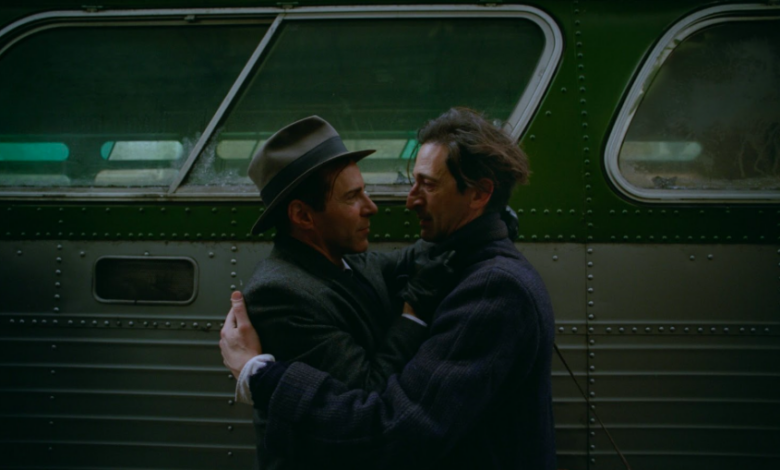‘The Brutalist’: A Towering, Unforgettable Epic

Julie Maescher ‘27 / Emertainment Monthly Staff Writer
Among the first images in The Brutalist, Brady Corbet’s sprawling and novelistic new film, are those of protagonist László Toth (Adrien Brody), a Jewish-Hungarian architect and Holocaust survivor, navigating his way through the crowded chaos of the boat transporting him to America. As he emerges onto the deck, we are greeted with a towering sight from his perspective: the Statue of Liberty seen upside-down and sideways. Accompanied by Daniel Blumberg’s majestic score, the sequence is an arresting and overwhelming note to begin the film on. It’s a memorable, if not necessarily subtle, announcement of the film’s primary thematic interests; The Brutalist is a sweeping exploration of the American Dream in all its contradictory allures and flaws, exploring both the enticing promises of the Land of Opportunity and the disappointing illusions they often manifest in. A three-and-a-half-hour epic complete with an old-school intermission and gorgeous 35mm VistaVision photography (the first American film to use the format since 1961), Corbet’s filmmaking deliberately recalls a bygone era of classic Hollywood in its grand scope and sumptuous textures, before ultimately inverting and weaponizing its structure to reveal a much thornier and more harrowing text underneath.
After spending the night in the brothels of New York City, László boards a bus to Pennsylvania, where his cousin Attila (Alessandro Nivola) has comfortably assimilated after immigrating years prior, having converted to Catholicism and married an American woman named Audrey (Emma Laird). Attila offers László a position with the couple’s furniture business, Miller & Sons; László takes the job in a heartbeat, even if it’s a far cry from his renowned architectural work back home in Hungary. Soon, the company is commissioned to build a library for the Van Burens, a wealthy family of old-money aristocrats, where László gets a chance to flaunt his Bauhaus training on a beautiful, modernist design for the space. However, from there, a series of disagreements and misfortunes leads László into poverty and the beginning of a long-lasting heroin addiction. One day, fate brings him a reunion with family patriarch Harrison Lee Van Buren (Guy Pearce), who has remained fascinated with László and his work since they went their separate ways. Van Buren commissions László to embark on a years-long project to build a Christian community center in suburban Pennsylvania, and the two men’s lives become entwined in ways at first fruitful and eventually destructive.
The Brutalist rests on Brody’s expressive and pained central performance; it’s some of the strongest work of his career, with a quiet softness and vulnerability that belie László’s more stubborn and self-destructive tendencies. Pearce is astounding as Van Buren, whose characterization could have easily come across as a tacky and overly broad metaphor for the evils of American capitalism if it weren’t for the captivating complexities and deceptive charm in how Pearce maneuvers on screen. Van Buren is a man who bears responsibility for the same societal structures and hierarchies that exclude and ostracize László; he feigns respect and friendliness towards László while ultimately treating his work as something to be exploited and nothing else. Their dynamic provides the underlying key to the film, as László begins to adopt some of the very same traits as Van Buren in his gradual assimilation.
László’s design for the community center – a modernist, pyramidal structure in keeping with the brutalist style of the film’s title – immediately lands as divisive among those in his company, just as the brutalist movement was at the time. The harshness and stark simplicity of brutalist structures have proven off-putting to many, but the designs are undeniable in their stripped-down honesty. The Brutalist resembles these very designs in its construction – large and monolithic in scale, it lays bare the capitalist decay woven into the American fabric in plain sight throughout history. The film is a stark confrontation of the American Dream as an illusion where one’s artistic visions and pursuits can easily be taken out of their hands to be corrupted, repurposed, and exploited. What stands out in the moment of watching The Brutalist is the arresting power and awe-inspiring scale of its old-school craftsmanship, but what lingers is the haunting and harrowing implications of the ideas on Corbet’s mind. It is a film that exists in conversation with the past and how it informs the present, exploring how generational history, pain, and suffering are built into the environments and physical spaces around us. Taken as a whole, the film is a staggering accomplishment, one that looms and towers large above many of its recent contemporaries.
The Brutalist screened as part of Independent Film Festival Boston’s Fall Focus series in early November. It will open in limited release on December 20, before expanding to more theaters throughout January.